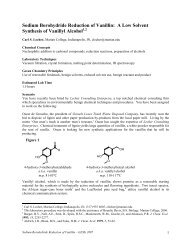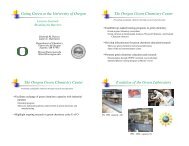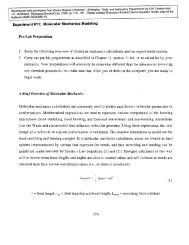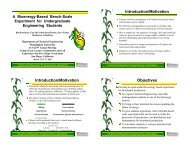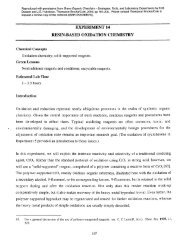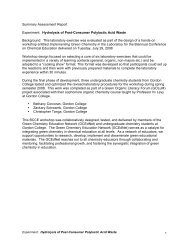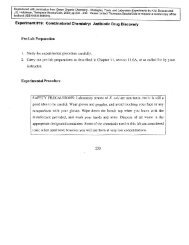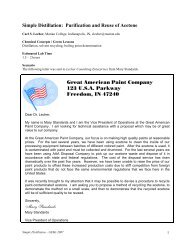A Greener Synthesis Creatine - Green Chemistry Center
A Greener Synthesis Creatine - Green Chemistry Center
A Greener Synthesis Creatine - Green Chemistry Center
Create successful ePaper yourself
Turn your PDF publications into a flip-book with our unique Google optimized e-Paper software.
A <strong><strong>Green</strong>er</strong> <strong>Synthesis</strong> of <strong>Creatine</strong><br />
Carl S. Lecher 1 and Ryan J. Bernhardt, 2 Marian College, Indianapolis, IN<br />
Chemical Concepts<br />
Addition to nitriles, vacuum filtration, melting point determination<br />
<strong>Green</strong> Lessons<br />
Benign solvents, reduction of excess reagents, safer reaction conditions, 100% atom economy, high<br />
reaction efficiency, benign product<br />
Estimated Lab Time<br />
Setup = 1 hour<br />
Workup = 1 hour<br />
Scenario<br />
Max Maximus, a chemist and local power lifting champion, has approached your company to discuss a<br />
business proposition. After reading an article in Mega Muscle Magazine about low quality creatine being<br />
sold in health and nutrition stores, Max is interested in the possibility of partnering with you on the<br />
development of an improved creatine synthesis.<br />
Background<br />
<strong>Creatine</strong> is a nitrogenous organic acid that is synthesized naturally by the human body. It is produced in<br />
the liver, kidneys, and pancreas from the amino acids glycine, arginine, and methionine (see Scheme 1),<br />
and may also be obtained from foods such as meats and fish. <strong>Creatine</strong> is found primarily in skeletal muscle<br />
and is fundamental to the energy metabolism of muscle cells. In skeletal muscle creatine exists in<br />
equilibrium with phosphocreatine. Phosphocreatine acts as an ATP reservoir. The reverse reaction<br />
provides a rapid source of ATP to the muscle cell, and appears to enhance anaerobic capacity, aerobic<br />
recovery, and protein synthesis. For these reasons, creatine is used by athletes both to increase muscle<br />
mass and to enhance performance in high-intensity exercise.<br />
H<br />
O<br />
N H 2<br />
H N OH<br />
glycine<br />
NH<br />
H<br />
N<br />
arginine<br />
H N H<br />
N H 2<br />
GATM 1<br />
O<br />
H 2 N<br />
ornithine<br />
OH<br />
O<br />
OH<br />
N H 2<br />
H<br />
N<br />
O<br />
OH<br />
NH<br />
guanidinoacetate<br />
adenosine S<br />
+<br />
H 2 N<br />
SAM O<br />
adenosine S<br />
SAH<br />
GAMT 1 - Guanidinoacetate N-methyltransferase; GAMT 2 - Glycine amidinotransferase;<br />
SAM - S-adenosyl methionine; SAH - S-adenosyl homocysteine<br />
Scheme 1. Biological Pathway for the <strong>Synthesis</strong> of <strong>Creatine</strong><br />
GATM 2<br />
OH<br />
H 2 N<br />
O<br />
H 2 N<br />
OH<br />
NH<br />
N<br />
O<br />
OH<br />
creatine<br />
1 Carl S. Lecher, Marian College, Indianapolis, IN, (317) 955 6005, clecher@marian.edu.<br />
2 B.S. <strong>Chemistry</strong> Marian College, 2008<br />
A <strong><strong>Green</strong>er</strong> <strong>Synthesis</strong> <strong>Creatine</strong> - organic - GEMS 2008 1
In the last 30 years, athletes and body builders have begun to take supplemental creatine in the form of<br />
powder or a pill in order to maximize the amount of creatine available to their muscle cells. <strong>Creatine</strong> is<br />
currently one of the best-selling sports supplements on the market with annual U.S. sales exceeding $400<br />
million. Companies worldwide have developed synthetic procedures to make creatine or creatine<br />
derivatives to meet this demand. Since creatine is a nutrient and not a drug, it not regulated by the Food<br />
and Drug Administration. Therefore, companies do not have to reveal or specify the synthetic procedure<br />
that is used. However, there is a common procedure that is thought to be used by many companies as an<br />
industrial procedure for the production of creatine monohydrate (see Scheme 2). <strong>Creatine</strong> is commonly<br />
synthesized from sarcosine and cyanamide (used in excess) in the presence of concentrated ammonium<br />
hydroxide (NH 4 OH), which contains about 28-30 percent ammonia in solution. 3 This procedure also uses<br />
two equivalents of NaCl as an additive to aid in the precipitation of the product.<br />
O<br />
O<br />
H 2 N N<br />
excess H N cat. NH 4<br />
OH<br />
+ + H 2<br />
O H 2 N N<br />
H 2<br />
O<br />
OH<br />
NaCl, H 2<br />
O<br />
OH<br />
Scheme 2. Typical <strong>Creatine</strong> <strong>Synthesis</strong><br />
NH<br />
<strong>Creatine</strong> can also be prepared by heating sodium sarcosinate and cyanamide in a mixture of water and<br />
organic solvent. 4<br />
Background - Impurities<br />
A common impurity found in creatine monohydrate is dicyanodiamide. While dicyanodiamide is<br />
generally not considered to be toxic in humans, there are no known benefits. Dicyanodiamide is typically<br />
prepared by the ammonium hydroxide catalyzed dimerization 5 of cyanamide in water (Scheme 3). These<br />
are the same reactions conditions used for the creatine synthesis. It would be anticipated that excess<br />
cyanamide remaining from the creatine synthesis would dimerize to form dicyanodiamide as an impurity.<br />
NH<br />
N<br />
H 2 N N<br />
cat. NH 4<br />
OH<br />
2<br />
H 2 N N<br />
H<br />
Scheme 3. Dimerization of cyanamide<br />
Another impurity occurring in the creatine monohydrate is sodium chloride. Sodium chloride is introduced<br />
to the reaction as an auxiliary reagent to aid in the precipitation of creatine monohydrate. Presumably the<br />
sodium chloride is trapped in the growing crystalline lattice. While neither impurity is necessarily<br />
hazardous, consumers are still purchasing inferior creatine monohydrate.<br />
<strong>Green</strong>ing the <strong>Chemistry</strong><br />
As a green chemist, you should identify three ways which could potentially improve both the greenness and<br />
quality of the creatine synthesized by this method. The first is to reduce the amount of cyanamide used<br />
from two equivalents to one equivalent. Not only would this improve the effective mass yield of the<br />
reaction, it should greatly reduce the generation of dicyanodiamide. The second is to eliminate use of<br />
NaCl. This would also improve the effective mass yield of the reaction, as well as eliminate the presence<br />
of any sodium chloride in the procedure. The third would be to eliminate use of concentrated ammonium<br />
hydroxide, which presents a host of safety problems, including causing severe skin irritation, skin burns,<br />
and severe irritation to the upper respiratory tract. Replacing concentrated ammonium hydroxide with<br />
household ammonia (which can be further diluted) would eliminate these safety concerns and the need for a<br />
fume hood.<br />
.<br />
3 Smith, A. L., Tan, P. J. Chem. Ed. 2006, 83, 1654-1656.<br />
4 Weiss, Stefan, Krommer, Helmut. United States Patent 5,719,319.<br />
5 A dimerization is a reaction linking two of the same type of molecules.<br />
A <strong><strong>Green</strong>er</strong> <strong>Synthesis</strong> <strong>Creatine</strong> - organic - GEMS 2008 2
In the lab<br />
Our primary goal is to see if these modifications can be done without dramatically lowering yields. In this<br />
experiment, you will perform the modified procedure and compare your results to the traditional procedure.<br />
Scheme 4. Reaction Scheme<br />
O<br />
O<br />
H 2 N N<br />
H N cat. NH 4<br />
OH<br />
+ + H 2<br />
O H 2<br />
.<br />
N N<br />
H 2<br />
O<br />
OH<br />
OH<br />
C 3<br />
H 7<br />
NO 2<br />
= 89.09<br />
m.p. 208-212 o C (dec.)<br />
NH<br />
.<br />
C 4<br />
H 9<br />
N 3<br />
O 2<br />
H 2<br />
O = 149.15<br />
m.p. 295 o C (dec.)<br />
Reaction Table<br />
Formula<br />
Name Weight eq mmol wt / vol<br />
cyanamide 42.04 1.00 10.0 0.42 g<br />
sarcosine 89.09 1.00 10.0 0.89 g<br />
Safety Precautions<br />
Cyanamide: Cyanamide is toxic. Wear gloves when handling.<br />
Experimental Procedure<br />
Reaction<br />
1. Obtain between 0.40 and 0.44 g of cyanamide. Record the mass directly into your notebook to the<br />
maximum accuracy of the balance. Add to either a 10 mL round bottom flask or a 20 mL<br />
scintillation vial.<br />
2. Obtain between 0.85 and 0.93 g of sarcosine. Record the mass directly into your notebook to the<br />
maximum accuracy of the balance. Add to the reaction vessel.<br />
3. Add 2 mL of dilute aqueous ammonia. 6, 7 Add a stir bar, cap, and dissolve with stirring.<br />
4. Stir for 60 minutes, or until the solution becomes chalky white. Remove from the stir plate and<br />
allow the flask to set undisturbed for at least 24 hours to allow the precipitate to form.<br />
5. Fill out your reaction table by calculating the mmol and equivalents of reagents used based on your<br />
masses. Show your calculations under the reaction table.<br />
Day # 2 – Isolation of the Product<br />
6. Collect the solid by vacuum filtration. Use small portions (~1 mL) of ice-cold DI water to aid the<br />
transfer of the solid into the filter funnel and to wash the product. With the vacuum applied, allow<br />
the solid to dry on the vacuum for about two minutes. Save your solid. Place your filtrate in the<br />
container labeled AQUEOUS FILTRATE.<br />
7. Air dry product to a constant mass in the fume hood for at least 24 hours.<br />
8. Weigh your dried product. Make sure to account for the weight of the filter paper.<br />
6 Prepared by diluting new household ammonia (usual concentration 5-10% ammonia) by a factor of five. Reduce the<br />
dilution for older ammonia. Watch out for surfactants and other additives in the ammonia!<br />
7 Safety note – As a general safety rule, solutes should be added to solvents. The resulting solution should go from<br />
dilute to more concentrated. This is because the solvation process for some compounds can be violently exothermic.<br />
A <strong><strong>Green</strong>er</strong> <strong>Synthesis</strong> <strong>Creatine</strong> - organic - GEMS 2008 3
Characterization and Calculations<br />
9. Determine the theoretical yield and percent yield for the reaction.<br />
10. Determine the melting point range for your creatine, as well as for a sample of creatine made from<br />
the traditional procedure.<br />
11. Generate an IR spectrum for your creatine. Assign the major peaks for the spectrum in your<br />
notebook. Also, submit your spectrum when you turn in your notebook pages.<br />
12. Confirm the identity of your product.<br />
Disposal<br />
13. When you are satisfied with your data and calculations, place your product in the container labeled<br />
CREATINE. The instructor will save this compound for future use.<br />
Assignment<br />
In addition to the lab notebook, answer the following questions:<br />
1. Propose a valid mechanism for the synthesis of creatine. Make sure to draw the reaction intermediates<br />
(including any charges) and to show the flow of electrons with curved arrows.<br />
2. Calculate the atom economy for the reaction.<br />
Atom economy = (MW desired product / combined MW of all reagents) x 100%<br />
3. Would you consider this reaction to be atom efficient? Justify your answer.<br />
4. Calculate the effective mass yield. Ignore the mass of the aqueous ammonia.<br />
Effective mass yield = (mass of desired product obtained / combined mass of all reagents used) x 100%<br />
5. Identify the possible components of the aqueous filtrate.<br />
6. What is the solvent for this reaction?<br />
7. Does the reaction need to be performed with the protection of a fume hood?<br />
8. Compare the melting point of your sample to the melting point of the sample of creatine made from the<br />
traditional procedure. What does this indicate with regards to the purity of the two samples?<br />
9. Did you meet the objectives for this reaction? Explain why or why not.<br />
A <strong><strong>Green</strong>er</strong> <strong>Synthesis</strong> <strong>Creatine</strong> - organic - GEMS 2008 4
Result Submission Form<br />
Lab Title: A <strong><strong>Green</strong>er</strong> <strong>Synthesis</strong> of <strong>Creatine</strong><br />
Name: ______________________________________________<br />
Semester and Year: _________________________________<br />
Reaction Scheme:<br />
O<br />
O<br />
H 2 N N<br />
H N cat. NH 4<br />
OH<br />
+ + H 2<br />
O H 2<br />
.<br />
N N<br />
H 2<br />
O<br />
OH<br />
OH<br />
Your Reaction Table<br />
Name<br />
C 3<br />
H 7<br />
NO 2<br />
= 89.09<br />
m.p. 208-212 o C (dec.)<br />
Formula<br />
Weight<br />
cyanamide 42.04 --<br />
sarcosine 89.09 --<br />
other reagents not needed in this table<br />
NH<br />
.<br />
C 4<br />
H 9<br />
N 3<br />
O 2<br />
H 2<br />
O = 149.15<br />
m.p. 295 o C (dec.)<br />
density eq mmol wt / vol<br />
Your Results<br />
Mass of Product<br />
Theoretical Yield<br />
% Yield<br />
Melting point range<br />
other values not needed in this table<br />
Explain any reasons why your yield would be lower than expected:<br />
Make at least 1 suggestion for improving the lab:<br />
A <strong><strong>Green</strong>er</strong> <strong>Synthesis</strong> <strong>Creatine</strong> - organic - GEMS 2008 5




